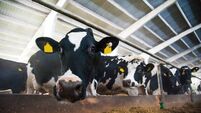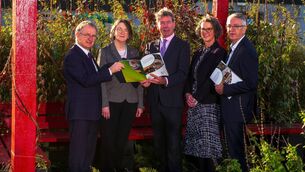Field of dreams or a plan that works?
The Government accepts the NDP is halved, saying they have to respond to new recession realities, and to lower growth rates projected for the immediate future. They claim with reduced land and building costs, they will get greater value from the new investment programme.
The Taoiseach boasted about the high level of investment planned, and the expected pay-off in terms of additional jobs.
But opposition spokespersons pointed out the substantial decline in planned expenditure compared with that envisaged in the national plan as recently as 2007. They emphasised the cuts, while the Government emphasised the investment. Rural organisations and deputies had concerns, about a perceived bias in favour of Dublin.
Is there is an urban bias in the programme, what are the changes in priorities?
Firstly, the total capital expenditure programme falls just short of €40 billion over seven years. In the national plan, covering a similar period, the planned capital spend was €75bn. So the programme is nearly halved But is everything cut in half? No, some plans are cut by substantially more, while others take a smaller cut, or none at all.
Given the surplus of housing, it is hardly surprising that projected expenditure in this area is slashed in half. Also slashed is expenditure on motorways (by about 60%), partly a reflection of a programme almost completed, partly a response to reduced economic activity and partly also, I suspect to the influence of Green ministers in the cabinet.
Given the unemployment situation, it is not surprising that capital support for industry is increased. A major determinant of the overall programme was the likely contribution to job creation of different schemes. The grants programmes of the IDA (foreign enterprises) and Enterprise Ireland (Irish-based) are seen as crucial, and they are budgeted to spend €600 million each over the seven years.
The programme of government-funded industrial research is set at €2.4 billion. The Government has placed a great deal of emphasis on this programme as a route to creating a “smart economy” but it has to be said the track record in job creation of this kind of investment is unproven.
Industrial investment, including the research component, amounts to about 11% of the total programme, up from less than 6% in 2008.
Another area getting priority is water services, where expenditure will remain at the recent levels of about €480m per annum. The flood relief allocation averages €70m per annum, compared with €27m in the recent past. While specific schemes are not identified, there is a reference to recent flood problems in the south and west.
So what about agriculture, fisheries, food and forestry? The overall spend is estimated at €1.63bn over the seven years to 2016.
But a substantial part of this is budgeted for the current year (€430m) and next year (€350m). The spend in subsequent years is only half that of 2011, at €170m. On the face of it, a very substantial reduction in capital spending is planned.
This is mostly accounted for by the Farm Waste Management Scheme, which will have involved a total government expenditure of €1.15bn, when final payments of grants are made in 2011. The investment work, of course, has long been completed by farmers, to enable them to meet the requirements of the EU Nitrates Directive, but the scale of uptake of the grant scheme was so large that the Government spread the grant payments over several years.
The absence of this substantial scheme (which the Government could say is no longer needed, like some of the motorways) accounts in large part for the reduction in capital spending provision in the areas for which the Department of Agriculture is responsible.
But the overall level of spending projected in the period 2012 to 2016 is not high, at €170m per annum, of which forestry accounts for €84m, agriculture and food €40m, fisheries €17m and other €29m.
Let us compare this projected investment with that of 2009 and 2010, excluding the Farm Waste Management scheme. This is done in the accompanying table.
The projected decline in Government investment is 19% compared with 2010 and 22% compared with 2009, apart from the reduction arising from the ending of the farm waste management scheme. Including this scheme, the reduction comes to 67%, compared with 2009.
One particular anomaly appears to be the reduction in the forestry programme. The current objective is to increase plantings to 10,000 hectares per annum, which might be achievable now that land prices have returned to more normal levels. Yet, the capital programme in this area is reduced by 25%.
Likewise, it could be argued that the increased output from Irish farms projected in the Food Harvest 2020 Report, published a week earlier, will require increased investment, some of which should come from the Government.












